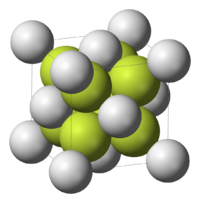- Thorium dioxide
-
Thorium dioxide  Thorium dioxide
Thorium dioxide
Thorium(IV) oxideOther namesthoria
thorium anhydrideIdentifiers CAS number 1314-20-1 
Properties Molecular formula ThO2 Molar mass 264.04 g/mol Appearance white odorless solid Density 10.00 g/cm3, solid Melting point 3390 °C
Boiling point 4400°C
Solubility in water insoluble Solubility insoluble in alkali
slightly soluble in acidRefractive index (nD) 2.200 (thorianite) Structure Crystal structure Fluorite (cubic), cF12 Space group Fm3m, No. 225 Lattice constant a = 559.74(6) pm[1] Coordination
geometryTetrahedral (O2–); cubic (ThIV) Thermochemistry Std enthalpy of
formation ΔfHo298−1226(4) kJ/mol Standard molar
entropy So29865.2(2) J K−1 mol−1 Hazards EU Index Not listed Flash point Non-flammable Related compounds Other cations Hafnium(IV) oxide
Cerium(IV) oxideRelated compounds Protactinium(IV) oxide
Uranium(IV) oxide dioxide (verify) (what is:
dioxide (verify) (what is:  /
/ ?)
?)
Except where noted otherwise, data are given for materials in their standard state (at 25 °C, 100 kPa)Infobox references Thorium dioxide (ThO2), also called thorium(IV) oxide is a white, crystalline powder. It was formerly known as thoria or thorina. It is produced mainly as a by-product of lanthanide and uranium production.[1] Thorianite is the name of the mineralogical form of thorium dioxide. It is moderately rare and crystallizes in isometric system.
Chemistry
The compound is radioactive due to the radioactivity of thorium. Thorium dioxide can be used as a nuclear fuel. (Refer to the article of thorium for more information on this application.) The high thermal stability of thorium dioxide allows applications in flame spraying and high temperature ceramics. Thorium dioxide was the primary ingredient in the X-ray contrast medium Thorotrast. Use of Thorotrast was abandoned when it was found to be a carcinogen, sometimes causing cholangiocarcinoma. Today, barium sulfate is the standard X-ray contrast agent. Thoria has the fluorite crystal structure. Few other binary dioxides have this structure: uranium dioxide, hafnium dioxide and cerium dioxide, not to mention plutonium dioxide. The band gap of thoria is about 6 eV.
Applications
Thorium dioxide is used as a stabilizer in tungsten electrodes in TIG welding, electron tubes, and aircraft engines. As an alloy, thoriated tungsten metal is not easily deformed because the high fusion material thoria augments the high temperature mechanical properties, and thorium helps stimulate the emission of electrons (thermions). It is the most popular oxide additive because of its low cost, but is being phased out in favor of non-radioactive elements such as cerium, lanthanum and zirconium.
A major use in the past was in gas mantles of lanterns, which were frequently composed of 99 percent ThO2 and 1% cerium(IV) oxide. Even as late as the 1980s it was estimated that about half of all ThO2 produced (several hundred tonnes per year) was used for this purpose.[2] Some mantles still use thorium, but yttrium oxide (or sometimes zirconium oxide) is used increasingly as a replacement.
Thorium dioxide was formerly added to glasses during manufacture to increase their refractive index, producing thoriated glass with up to 40% ThO2 content. These glasses were used in the construction of high-quality photographic lenses. However, the radioactivity of the thorium caused both a safety and pollution hazard and self-degradation of the glass (turning it yellow or brown over time). Lanthanum oxide has replaced thorium dioxide in almost all modern high-index glasses.
The melting point of thorium oxide is 3300°C - the highest of all known oxides. Only a few elements (including tungsten and carbon) and a few compounds (including tantalum carbide) have higher melting points.).[3]
Thorium dioxide is a Welsbach material. It has been suggested[4] that these chemicals could be sprayed into the upper atmosphere to reflect sunlight and thus lower the global temperature.
Thorium dioxide is a catalyst in many chemical reactions, including the Ruzicka large ring synthesis, petroleum cracking, conversion of ammonia to nitric acid and preparation of sulfuric acid.[5]
Thoria dispersed nickel finds its applications in various high temperature operations like combustion engines because it is a good creep resistant material. It can also be used for hydrogen trapping.[6][7]
References
- ^ Yamashita, Toshiyuki; Nitani, Noriko; Tsuji, Toshihide; Inagaki, Hironitsu (1997). "Thermal expansions of NpO2 and some other actinide dioxides". J. Nucl. Mat. 245 (1): 72–78. doi:10.1016/S0022-3115(96)00750-7.
- ^ Greenwood, Norman N.; Earnshaw, A. (1984). Chemistry of the Elements. Oxford: Pergamon. pp. 1425, 1456. ISBN 0-08-022057-6.
- ^ Emsley, John (2001). Nature's Building Blocks ((Hardcover, First Edition) ed.). Oxford University Press. pp. 441. ISBN 0198503407.
- ^ Chang, David B; Shih, I-fu "Stratospheric Welsbach seeding for reduction of global warming", US Patent No. 5003186.
- ^ Patnaik, Pradyot (2003). Handbook of Inorganic Chemical Compounds. McGraw-Hill. p. 931. ISBN 0070494398. http://books.google.com/?id=Xqj-TTzkvTEC&pg=PA931. Retrieved 2009-06-06.
- ^ Mitchell, Brian S (2004). An Introduction to Materials Engineering. and Science for Chemical and Materials.. p. 473. ISBN 9780471436232. http://books.google.com/?id=iQQcERxsNywC&pg=PA473.
- ^ Robertson, Wayne M. (1979). "Measurement and evaluation of hydrogen trapping in thoria dispersed nickel". Metallurgical and Materials Transactions A 10 (4): 489–501. doi:10.1007/BF02697077.
Thorium compounds Categories:- Oxides
- Thorium compounds
- Refractory materials
Wikimedia Foundation. 2010.
